The Secret Origin and Lasting Impact of the Marvel Universe Cards
This article first appeared on Multiversity Comics on October 21, 2014, but was written by me. It has been published here as well with their very kind permission.
Do you remember how you first got into comics?
It’s a question I think about fairly often, if only because I don’t remember exactly how I did. The specifics of it are lost to the ages, just like they are for many people, as there are so many different ways to get into them depending on when you started and what you were interested in.
But for kids of a certain generation – namely ones who grew up in the late 80’s and early 90’s – there were a few seminal items. My comic book witches brew wasn’t a wholly unique concoction, and it’s a recipe I share with many similarly aged comic fans.
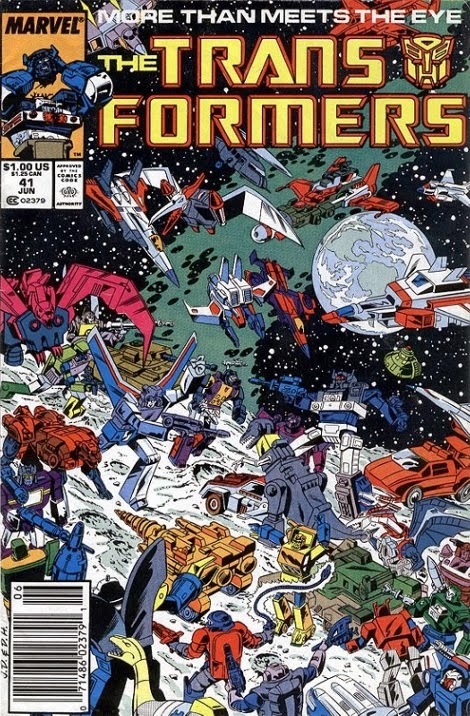
There were Marvel’s Transformers comics, which were the first comics I can remember loving. Part of that was because at the time Transformers: The Movie and The Goonies were 1a and 1b as my favorite movies ever at the time, but the cover to “The Transformers” #41 and its mass of battling Transformers was the first time comics really, truly blew my mind.
Later on, what really sealed the deal for me were X-Men: The Animated Series and Batman: The Animated Series. Those two shows helped me understand serialized storytelling and appreciate the depth and magic that existed in both of those worlds. To do this day, those are amongst my favorite X-Men or Batman stories ever.
But the one thing that stood out above the rest for me wasn’t even a comic, or even a comic like story. For me, it all started with the Marvel Universe cards that Marvel and Impel produced back in 90’s. Those cards and the ones that followed in later sets helped introduce me to all kinds of characters I never knew while also making everything about the Marvel universe feel more accessible than ever before.
The cards started with the 100 card Marvel Universe Series One set, which featured Marvel’s greatest heroes, like Iron Man, Wolverine and Captain America, and some less memorable ones as well, including the almost instantly forgotten Foolkiller. The cards attracted fans and collectors thanks to art by names like Arthur Adams, John Romita, Sr. and Walt Simonson while also feeding the minds of everyone who bought them with fight stats and important factoids about the characters, Marvel history, and much more.
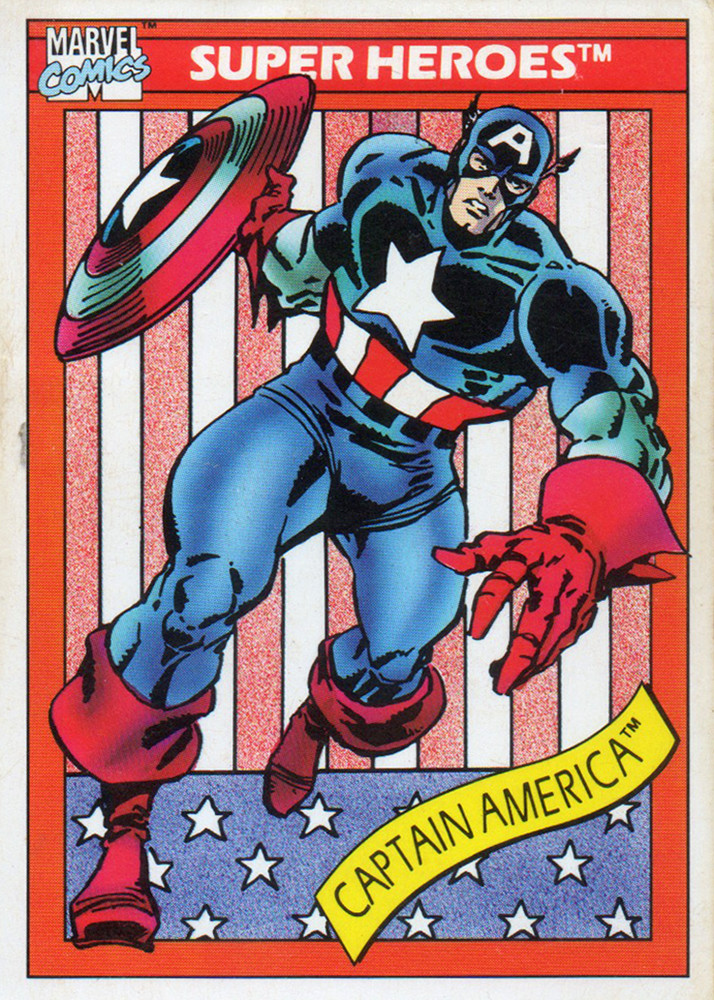
I remember going home and tearing open packs and learning all kinds of random things that have stuck with me to this day. My opinion of the Celestials was permanently bolstered by the way they broke the power level scale in Marvel Universe Series Three. Jim Lee’s Rogue card in his solo X-Men series was, to that point, the single most beautiful thing I’d ever seen. The Aunt May card in the first series made me laugh because of how the stats were changed to “pies baked” instead of “fights won”. These weren’t just cards. These were the heart and power of the Marvel Universe finally being revealed to fans of a certain age, and many others found them similarly exciting.
“I loved the thrill of opening a pack and finding out what new cards you now owned,” Matt Wilson, colorist of “Thor” and “Daredevil” shared. “I remember I used to open the packs upside down so I would see the back of the last card rather than the image on the first card.”
“I guess I thought that seeing the text on the back rather than an image would give me that much longer before I was either disappointed by a getting a card I already owned, or conversely, it (would) extend the excitement of the reveal of a new card.”
Cartoonist Michel Fiffe (“Copra”, “All-New Ultimates”) shared that sentiment, although his was more art driven even when he was younger.
“It was exciting to rip open a pack and see who drew what — that was the thrill. Looking at the cards right now, that thrill rushes back.”
For many though, they weren’t just an exciting hobby, they were one of the gateways into the world of comics. They hit at the right time, just as the comic and trading card booms of the 90’s were taking hold. The cards either helped introduce them to Marvel’s comic universe, or they helped solidify the affinity for them. They were hugely important items in Marvel’s history, but what’s the story behind them, and how did they help influence not just readers, but the creators of tomorrow?
Let’s find out as we explore the secret origin of the Marvel Universe cards.
The Key Players
“I’ll be honest. They didn’t come from me,” said Bob Budiansky, the former Executive Editor and Special Projects Editor at Marvel.
“There was someone at Marvel who made a deal with Impel (the trading card company the first sets were produced by). They made a deal to do these trading cards, and Tom DeFalco – the Editor-in-Chief at Marvel at the time – came to me, and I was the Special Projects editor so I was the natural editor to do this,” Budiansky explained. “He came to me and said, ‘we have this new project to do a set of trading cards.’ Marvel had done trading cards in the past but I think they had just licensed them out to people and they were done really on the cheap. They would find pickup art from a comic book and paste it on there, and they’d look pretty crappy actually.”
“Tom came to me and wanted to do it right and make it exciting for the fans. We wanted people to feel that these were trading cards of Marvel comic book characters made by Marvel comic books.”
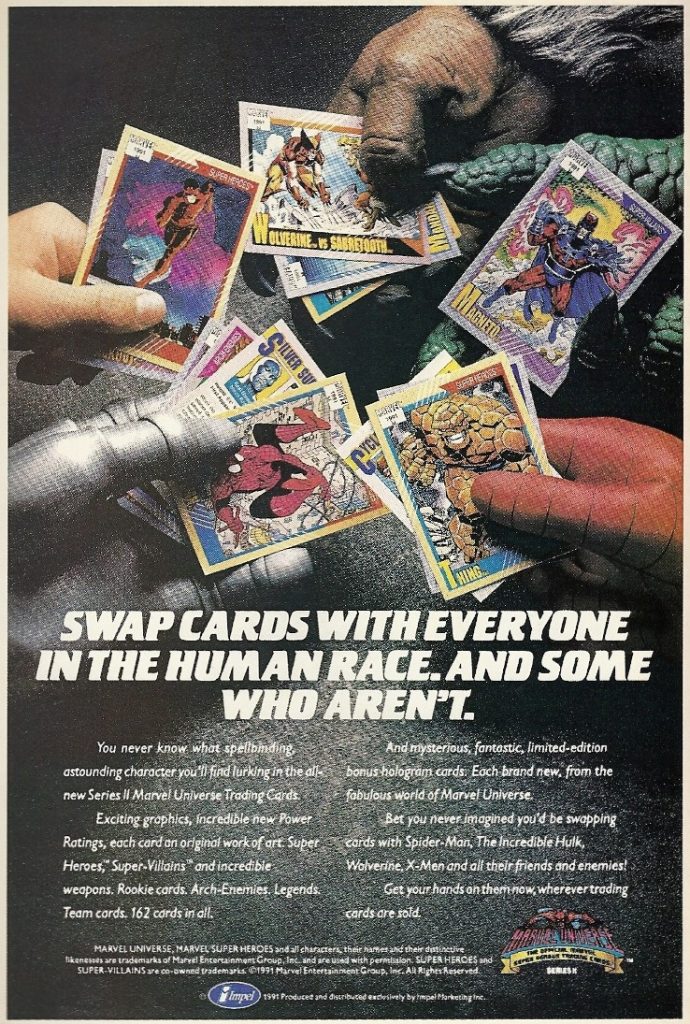
At Marvel, Budiansky was one of the two key architects on the project, with his assistant at the time being the other one. He’s a pretty familiar name with comic fans of today.
“Back in those days, Marvel didn’t have a full division devoted to providing key art and licensing support and so forth. There was just Special Projects, which was just two guys, me and Bob,” said Tom Brevoort, Marvel’s current Senior Vice President of Publishing and Executive Editor.
At the time, Special Projects had a rather enormous purview. In Brevoort’s words, Special Projects handled “anything that wasn’t a real regular monthly Marvel comic,” and that included approving all the licensed products that came through, creating package art, boxes, ads and everything there, and developing special projects like posters and a graphic novel adaptation of the X-Men animated series.
With most projects, Budiansky and Brevoort would wear a lot of different hats, but for the original Marvel Universe cards, it was a particularly sprawling project that touched on many different aspects of Marvel at the time. Editors that worked for Budiansky like Greg Wright and David Wohl were directly involved at times, helping pull in information for the various cards, while writers like Dwayne McDuffie helped contribute to the copy used on the backs of the cards.
It was a team effort, but at the center of the project through its most important iterations were Budiansky and Brevoort.
“From a creative standpoint, Bob was the lead guy,” Brevoort said. “We worked hand-in-hand with the folks of the era over at Impel. They basically brought their trading card experience to the table, and Bob – assisted by myself – brought his knowledge and understanding of not just Marvel but of licensed materials in general to the table.”
“I know Tom (Brevoort) was key,” Budiansky said. “Tom was my assistant at the time. I was the head guy on the cards, but as time went along and I had other responsibilities, I was able to delegate more and more, especially to Tom, who as things developed was the editorial liaison with the writers and the artists.”
How The Cards Came Together
While Brevoort shared that as a licensed product, the goal “was to put money in Marvel’s coffers,” both he and Budiansky agreed that their primary goal was simple: make them as worthwhile as they possibly could.
“If a Marvel fan was going to be drawn to pick up this thing, (we wanted to make sure) they would get an experience from (the cards) that they would feel was in line with and worthy of their time as a Marvel reader,” Brevoort said.
“We basically wanted to make them good.”
Budiansky believed that was all they really could do as the people at the head of this – or any – project.
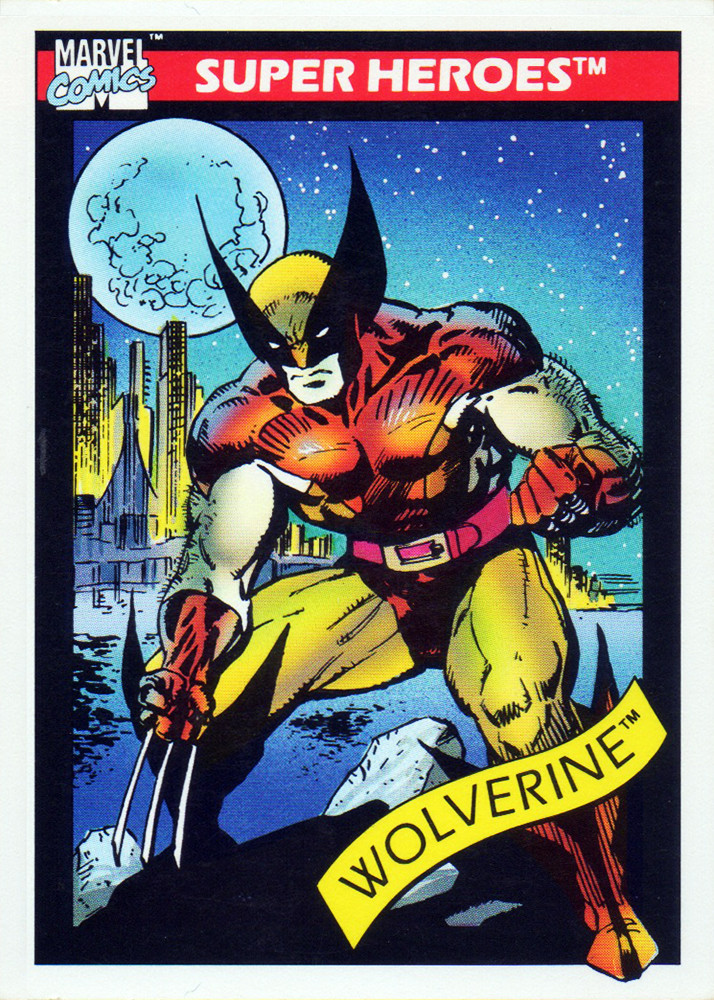
“At that time, I’d been working at Marvel for a number of years, and my experience was if we just did what we thought was good, whether it’s in a comic or on a poster or on a card…that’s the most that we can do,” he said. “That was the sole goal in all the sets of cards we were making.”
“The idea to do this came up, and I remember that the first thing we had to do was do 20 cards as sort of a sample test. Tom Morgan drew those, and those all ended up in the first set,” Brevoort said. “Those went over really well, so we got an agreement together and produced the full line.”
After that, it was all about making the sausage, and while it was a complicated process with many players; the beginning was simple at the very least.
“We’d plot it out together and we’d discuss different artist options and who we’d like to do this character or that character, and (Brevoort) would be the guy who would get on the phone and talk to people,” Budiansky said.
“Typically at the start of the set, we’d have generated a list of character cards and things. That was done partly by common sense – there’s going to be a Spider-Man card and a Thor card and an Iron Man card – and then I would go office to office and talk to the various editors and say, ‘Hey Bob Harras, do you have any exciting new things coming up in this window of time that should be represented in the trading card set?’” Brevoort shared. “He might say, ‘well yes, we’re going to be launching X-Force and we’re going to have these characters – Shatterstar and Feral and Warpath’ and I’d say ‘okay’, and I’d write them down.”
“I’d draft them up…it’d look like a little flip booklet. It was 11″x14″ paper, I would break it down into a chart that would list 10 or 20 cards on a sheet and a spot for who the penciler is and who the inker is, are the inks done, who’s coloring it, etc.”
As Budiansky shared, this project was very much an attempt to bring the quality and connection of Marvel’s comic product to the cards, so that made it easier on them to bring these cards to life. They used the comics as their bible.
While the character list was easy to do, figuring out what information to include wasn’t quite as simple. Both Budiansky and Brevoort had limited experience with cards – Budiansky collected baseball cards in the past, but not at the time – so they had rough ideas of what to include, but some of the cards’ most memorable features were driven by Impel.
While I wasn’t able to speak with anyone at the card publisher – which over the years has changed hands a number of times – both Budiansky and Brevoort shared that it was at Impel’s suggestion that statistics like the fight stats of the first series and the power levels that followed should be included as elements on the cards. Much to my chagrin, Brevoort revealed the truth of the first series and its fight stats.
“Those were totally made up. Those were completely bogus. They drove us nuts,” he said. “The card guys were very big on the idea that there be win and loss stats. In dealing with trading cards, whether it’s baseball or football or whatever, you’re looking for stats. Those were stats they were very comfortable with. That first year we couldn’t talk them out of it, and nobody on Earth was going to research that. It would take way too long.”
That sound you just heard was my childhood crumbling, as I found out that Dagger (of Cloak & Dagger fame) was not in fact one of the most successful heroes of Marvel’s oeuvre like her 73% winning percentage indicated to me as a kid.
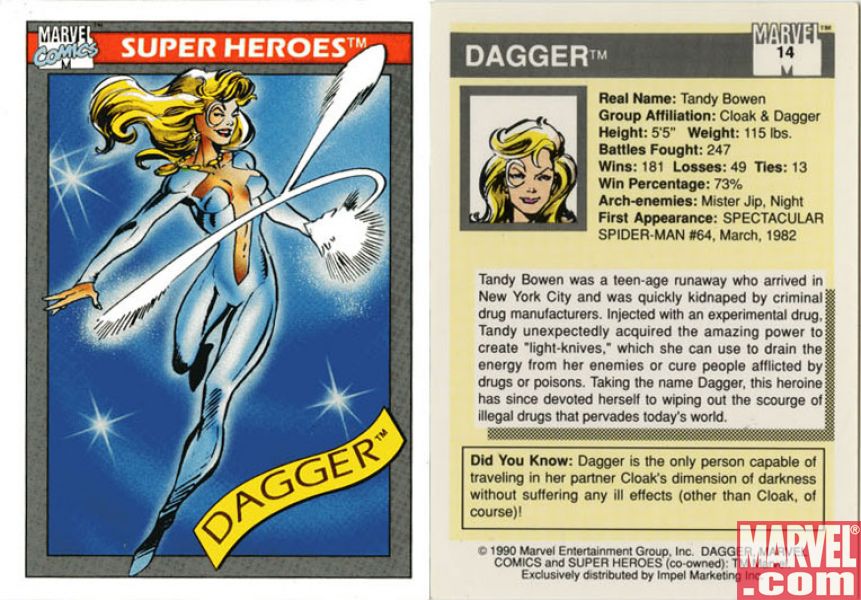
Stats later on were built on a rock solid foundation however: the old Marvel Handbooks, which were governed by editor Mark Gruenwald.
“For the Handbook, Mark Gruenwald had worked out something like 27 categories and each category had, you know, depending on the category anywhere from ten to 20 ranges of levels,” Brevoort shared. “Once we did the power ratings, we basically sat down – Bob and myself – and sort of crunched that all down to get you six categories that had seven ranges.”
“That’s why some of those ranges are so wide, and why some people would wonder why two characters who seem to be on a slightly different scale would have the same rating in a particular attribute. Part of that reason is you’re compressing an infinite amount of information into seven categories.”
The Handbooks were an excellent resource even beyond the power levels. As Budiansky said, “they wanted to try to be somewhat encyclopedic about it,” as those handbooks themselves were. That led to the inclusion of things like height, weight, eye color and other character information, as well as other easy-to-digest factoids.
“The ‘Did You Know?’ from the first set…I took that off of baseball cards I collected as a kid. There was always an interesting fact that they’d throw in for each baseball player, and I came up with the ‘Did You Know?’ idea from that.”
Budiansky and Brevoort were dealing with an immense amount of information in creating these cards, but thankfully, as Brevoort pointed out, Budiansky was just the man for the job.
“Bob had a lot of experience in doing the various Transformers bios, so he was able to codify the writing of trading card backs not quite to a formula, but a format.”
From there, it was all about making the magic happen and getting the details together. Brevoort, McDuffie and a few others wrote the copy for the first set, but Budiansky wrote the majority of them, including the 20 card test Tom Morgan was the artist for. Budiansky was really the driving factor more than anyone on the first set, as Brevoort shared that Bob was heavily editing – or at the very least copy editing – all of the things that came through on the cards.
“He had a strong sense of what the style and what the tone and the flavor of the language should be. How to say things in an expedient manner, because on the back of a trading card you only get like 75 words to tell you everything you need about a character,” Brevoort said.
Each card has two sides to it though, and we haven’t even talked about the most important one yet: the art driven fronts.
The Iconic Look of the Marvel Universe Cards
When it came to the art, there were two things Marvel looked for above anything according to Budiansky.
“I think we were looking for artists that were associated with those characters,” he said. “And as far as what we were looking for in the actual illustrations, when you have a single illustration of a character, I’m looking to get an iconic piece of artwork.”
It was an easy sell for artists, as special projects gigs like this one were appealing because they paid well for comparatively little work.
“The price to do an individual card where you’d do a full front and usually an inset on the back that was a headshot or a little image, those would pay – I think – half page rate (for) what amounted to about a quarter page of work. It paid about double rate,” Brevoort said. “And they didn’t take a lot of time. There wasn’t a storytelling component. It was closer to doing a cover.”
Because it was an individual character, it was even easier for most artists than a cover, and it gave them a sandbox to really create an iconic shot of a character that the artist either liked or rarely tackled. This appealed to artists, and combined with the good money to make Budiansky and Brevoort’s lives really easy when it came to finding artists.
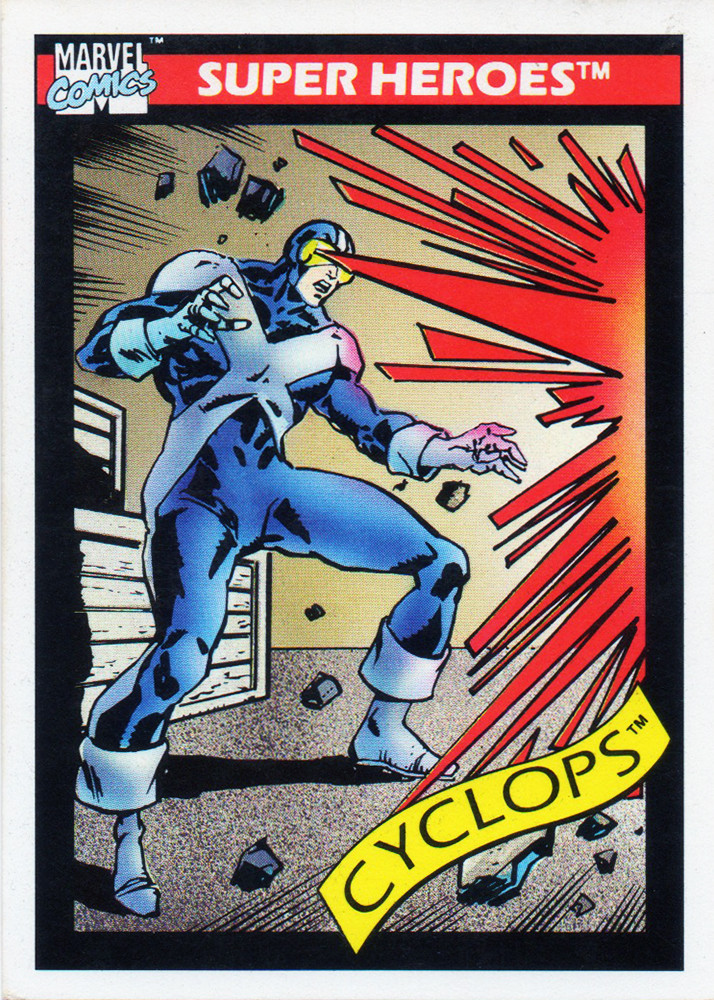
“It was quick and easy money, and I did get to draw a crap load of characters I had never drawn before, from the Avengers to Baron Zemo,” shared Mark Bagley (“Hulk”).
Another thing that appealed to artists was that due to the nature of the cards – they were effectively quarter pages – the artists were never hired to do just one.
“Typically, you know, we wouldn’t try to get someone to do one card. So if Ron (Frenz) was going to do a card, we’d say that’s a quarter of a page, so do a full page, do four cards and you’ll get paid for the equivalent of two pages,” Brevoort said. “You’d do the Thor card and the Loki card and we have a greatest battles card that was Thor related and the fourth was sort of random, ‘who do you like? Do you like The Beast? Do the Beast!’ That was very much the sort of thing that happened.”
Even with how appealing they were – and they were, as artists like Bill Sienkiewicz, Erik Larsen, Marc Silvestri, John Romita, Jr. and more contributed to sets – sometimes artists would surprise Brevoort with how interested in the gig they really were.
“The second set, I remember Art Adams did like 30 of them. And being Art Adams, he was a loon about it,” Brevoort shared with a laugh. “Not only did he do so many of them, he did them big. The original art on his battles cards, the horizontal ones, he was getting paid effectively to do a half page to do a quarter page thing, but he’d do them half a page size, and some of them he’d do full page size.”
“They’re reduced down much further than a lot of the other cards were. It was just to get the result he wanted and to do the thing he did, he wanted to do them that way. Art just happened to have a window there and he was excellent at doing the licensed art and could draw any character,” he added. “So I think he was probably one of the first guys we called for the second set of cards. He just went down a list and said, ‘I’ll do these 30.’”
“’Okay, great!’” Brevoort recalled with a laugh. “’As long as you can get them done, do those 30! I only have 70 to worry about now.’”
“The first series was my first go round. I don’t recall how many I did. I found out I really liked doing them,” Adams said. “They liked having me do them, so I was one of the early ones they called for the second series so I ended doing a lot more for that. I really liked doing them. They were really fun and they gave me a chance to draw lots of different characters.”
“A little iconic shot of each character which I liked doing,” Adams added.
Arthur Adams – or Art, as many know him as – was regularly cited as one of the best and most memorable highlights of the card sets by everyone I spoke to.
“Those Art Adams cards are amazing,” shared Ed Piskor of “Hip Hop Family Tree” fame. “Art Adams’ work is kind of a rare morsel to get ahold of anyhow, but the way he drew everyone was so dynamic and cool…this guy could draw so (well).”
“You just wanted him to draw everyone.”
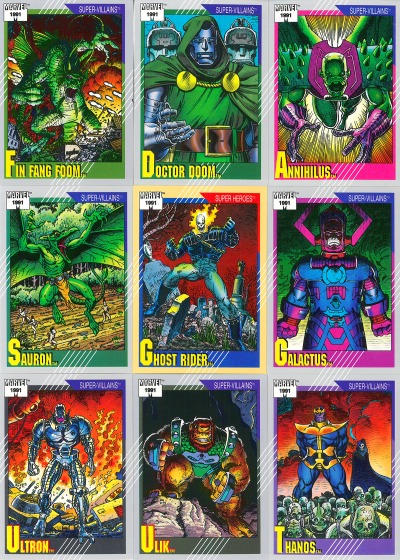
Piskor’s wish was in fact Adams’ desire, although an unfulfilled one.
“I said (after the second set), ‘you know, I’m the main contributor for the second series. Why don’t you let me do the third series?’” Adams said. “And then they said, ‘no, we can’t do that. We could never do that. We’ll never just have one artist do the one series. That’d be stupid.’”
One year later, Marvel released a set of X-Men cards entirely drawn by Jim Lee, and from there, several other complete sets were drawn by a single artist. Adams was never one of them.
Regardless, his cards were hugely impactful, and one of the interesting reasons why is a special paper he used for the job: duotone.
“On the second batch, I bought some duotone paper where you add these two different chemicals to it and it makes cross hatching basically,” Adams said. “You draw, you pencil on it, and then you use a brush and paint on these things which are different types of vinegar or something, and then it would bring out the lines on the paper. I just go over and finish inking from there.”
“It was really fun experimenting with this new stuff and it was a bunch of characters I always liked drawing. I liked drawing the secondary and tertiary characters, which was fun to do.”
This paper, which was used by Eastman & Laird on their “Teenage Mutant Ninja Turtle” series and Wally Wood in the 1950’s and 60’s, stood out at the time to current artists I spoke to like Fiffe and Piskor.
“As a kid, I’d stare at those lines thinking that he just used a ruler to create these perfect lines,” Piskor said.
Piskor also cited Adams’ level of detail on the cards as something that boggled his mind at the time – “I remember staring at it and seeing these tiny Savage Land men and women, and thinking, this guy can draw 3 millimeter figures better than anyone can draw full size characters” – and a big reason why was the much larger size of paper he was drawing at.
“The battle cards I did pretty big. I don’t even remember why. I think just because I’m a goober and I just wanted to spend extra time drawing a bigger picture,” Adams said with a laugh.
As the cards increased in popularity, Marvel started exploring other directions to take them and the aforementioned single artist card sets were a natural one for them to go in.
“The idea came up to do an X-Men set, and X-Men was clearly the most popular franchise we had going at the time. And Jim was still with Marvel luckily and I’m pretty certain I was the person who said ‘let’s get Jim to do the whole set.’” Budiansky said. “He agreed to it, and he did a tremendous job.”
This appealed to other artists for many obvious reasons, according to Brevoort.
“Once that happened, people knew that was a thing you could do,” he said. “For maybe less work or work of a different type than drawing issues of a comic, you could do very well and a lot of people are going to see it and come up to you at shows and ask you to sign the card and it’s going to be a thing.”
Soon thereafter, other artists got their turn, as Budiansky recruited painter Joe Jusko – who provided the backgrounds for the third series – to create the first fully painted Marvel Masterpieces series.
“In an effort to make each new set something different, it was determined that the next logical step was to produce a fully painted set that harkened back to the great painted trading cards of the 1960’s,” Jusko said. “I was pretty much Marvel’s main painted cover guy at that point so I guess it seemed logical to ask me to do the project.”
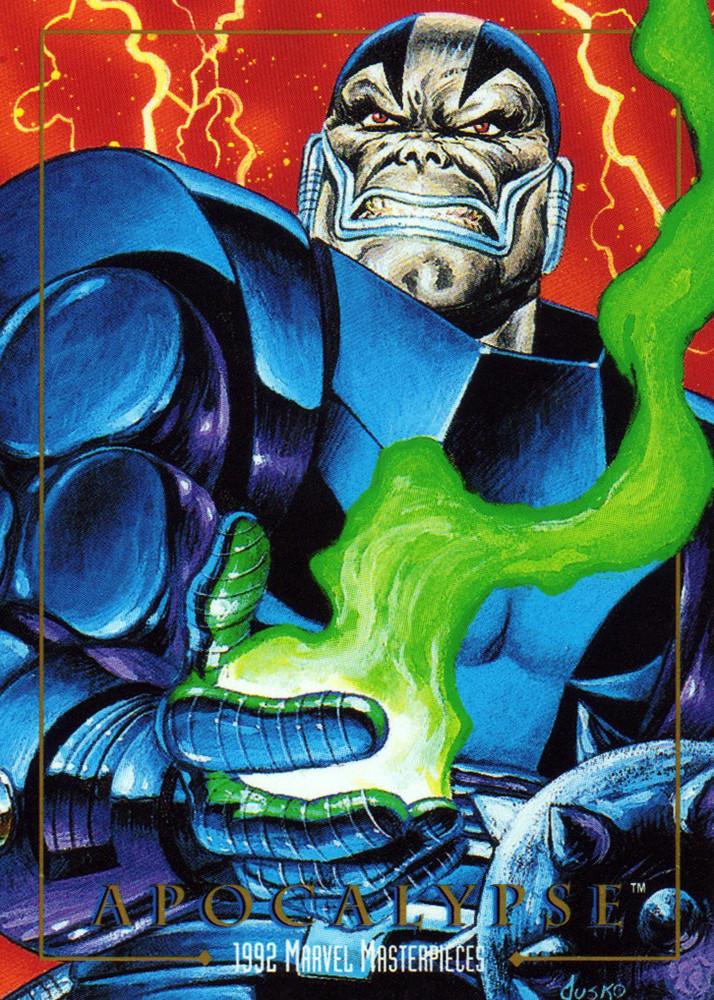
The project was one that Jusko took a lot of pride in, even though it was a hellacious effort for him to get them finished. He had to create all 104 cards in just over three months, which was a Herculean effort that led to him passing on the next set even though it was an enormous success. In fact, to this day, Jusko says this is the project that he is most known for.
“My wife attends most shows with me and finds it amazing that I still sign more of those cards than anything else I’ve ever done,” he shared. “People tell me those cards are the reason they got back into comics or into comics for the first time, or they’re the reason they started to draw. The enthusiasm and passion with which they reminisce about the cards is truly humbling.”
“I have a feeling no matter what I do in my career from that project forward those cards will be my professional legacy, and I’m okay with that.”
Bagley, who worked on several sets, was asked to put together a Spider-Man set during his run on “Amazing Spider-Man”, and it’s something that he looks back on very fondly.
“It was such an honor to be asked to do it. They could have asked John Romita, Jr., they could have asked Alex Saviuk. Hell, Gil Kane was still alive,” Bagley said. “But they asked me to do it. I thought that was such an honor.”
For many fans, while those cards were well loved, the biggest impact they had was a little known fact.
“That was the set that got me the Ultimate Spider-Man gig, because Bill Jemas was in charge of that set, and working on those cards made him a fan of mine,” Bagley shared. “I couldn’t have told you that to save my life before that because he was up the food chain from me. That’s why he wanted me on Ultimate Spider-Man: from those cards.”
While only an artist for one card in specific – the Mr. Marvel card of Stan Lee from the first Marvel Universe set – one of the most influential people to the visuals of the cards was Arnie Sawyer. In the process of wrestling with Sawyer to get that Mr. Marvel card into the set (Sawyer created it as a piece of art for FOOM Magazine), Budiansky found out that he was a graphic designer who owned his own studio and was a huge comic book fan.
“So after that he became our designer. He designed set after set after set, and I don’t know how many he did, maybe the next ten sets that I did, but he did a phenomenal job,” Budiansky said. “He had a great staff and great ideas and it was wonderful working on those cards with him. It was kind of funny how that worked out, (but) we found the guy and he was great.”
From that random card, Marvel picked up a designer who was one of the secret and forgotten architects of the look and feel of these cards. His work started with the second series of Marvel Universe cards, right after the cards exploded in popularity.
A Rollicking Success and a Lasting Influence
“The thing about those cards, the first year especially, was they were way more successful than anybody involved had any inkling they would be,” Brevoort said.
“They were enormously successful and within a four or five year period, I was responsible for eleven sets of trading cards between that Impel set and when I finished up in 1994 and 1995,” Budiansky said of the success.
The popularity shocked Jusko, but in a very happy way.
“Stores could not keep them in stock and I was traveling everywhere for signings. I remember in December of 1992 I did signings in Lafayette, Dallas, Chicago, LA and Las Vegas in seven days,” he said. “Skybox sold out (of) the entire numbered print run of 350,000 boxes. They also produced a 20,000 run tin set that sold out and Marvel collected the art in a four-issue comic set with five new images per book.”
Part of it was bolstered by the nature of trading cards and tactics Impel brought into the product originally.
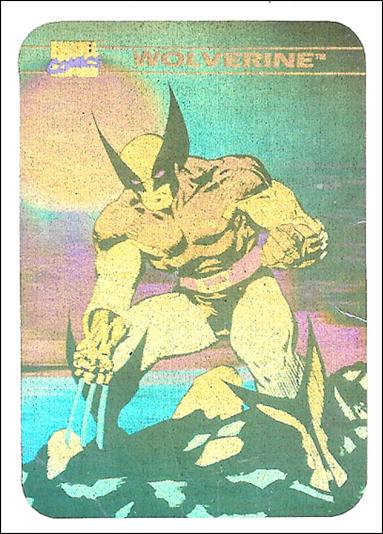
“In certain cases the trading card guys would show us a card technology. ‘We can do holograms, so we should do chase cards,’” Brevoort said. “They would explain to us the methodology of chase cards. ‘They are rare cards, you pack them in. You get one for every X number of packs.’”
“The chase cards, because they’re more rare and difficult to get – it’s what the name implies – you chase them by buying packages. And that was a big part of what drove the trading card business.”
Whatever the reason, the cards were selling like hotcakes, and the card companies couldn’t be happier about the deal they cut with Marvel.
“One of the people I’m friends with on Facebook is Joe Jusko, who I worked with on the Marvel cards he did completely on his own,” Budiansky said. “He made the note he was given a plaque – as was I – and the plaque had some of the cards in the plague and some words saying “in honor of…” His point was when did a trading card company give someone a plaque commemorating the great job that he did?”
“That’s how much the card companies loved what we were doing.”
There were other contributing factors, including the 1994 baseball strike creating a hole in trading card shops that the Marvel cards filled, that they were available in places like toy stores and big box stores, and more. But for the people who collected them, the kids of that era, the answer to why they were popular was much simpler: they were just awesome.
“I think there was just this fever in the air in general, that jittery pre-Image charge that Marvel Comics had…and the second series of cards really captured that,” Fiffe said. “I also liked their dress. The second series maximized the art while giving it a sense of cohesion with its design and warm palette.”
“The cards, just like the related video games at the time, made you feel deeply in tune with that universe. Marvel had this confident momentum and everything seemed to make sense as an entity. The cards just helped support that.”
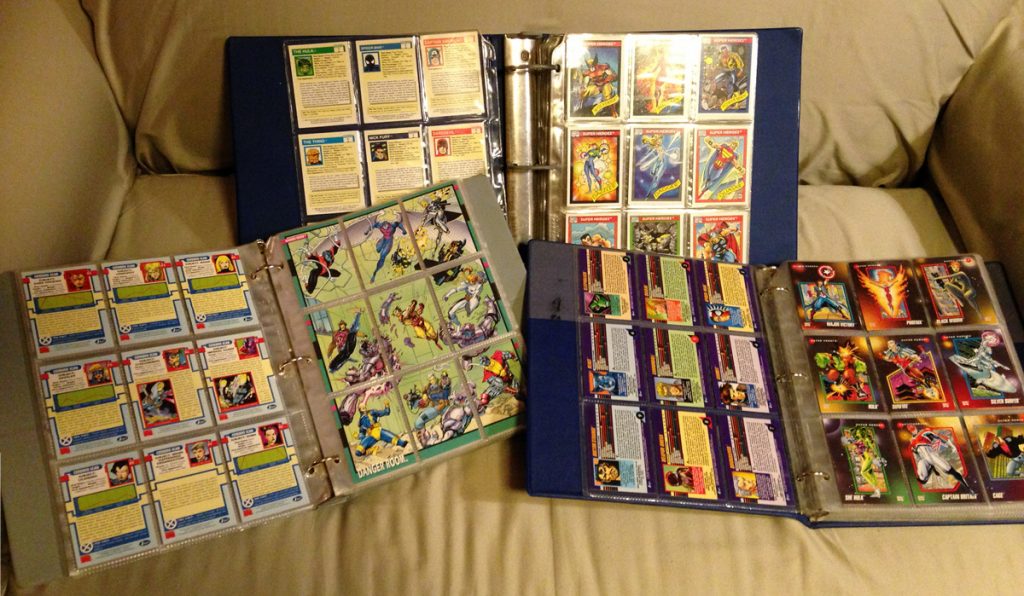
Wilson still has his cards, and remembers everything he loved like it was yesterday, specifically citing the excitement tied to opening a pack, their collectability, and more specifically, the stats and trivia they provided.
“I loved the variety of info you could find in the cards. I loved all the stats and trivia on the backs of cards, like the power rating charts that spelled out the character’s abilities,” Wilson shared. “Finally, I know which character is stronger or smarter!”
“I’ve always nerded out about stats, charts, graphs, and maps, so the back-of-the-card stuff was right up my alley.”
Dustin Weaver, artist of “Infinity” and “Edge of Spider-Verse” at Marvel, shared that they were a game changer for him.
“The cards really were what got me into comics. Before I saw those cards, I had tried to get into comics, but it was tough. I didn’t know what was going on. I remember not knowing what comic series was what. I couldn’t find my way into any of it,” he said. “When some friends of mine came to school with those cards I could finally get some information, some context for the characters and what their stories were.”
“I could read the backs of the cards and determine what stories interested me, then when I picked up an issue of Wolverine or Ghost Rider, I had some context for what I was reading. I was in. I knew what was up.”
Wilson agreed with that sentiment.
“I remember I was very confused and a bit intimidated by getting into comic books,” he said. “With the cards I could be introduced to a wide range of things in the Marvel universe much quicker, and in an easier way.”
“I think I liked the simplicity of it. It was essentially the Marvel Wikipedia of 1992,” Michael Walsh of “Secret Avengers” said. “I could instantly look up any character and find their origins, power set, and even statistics so I could measure their ‘energy projection’ and ‘mental powers’.”
“I loved that part of it and would scour the cards for hours trying to find what would be the best fights.”
For Piskor, they were an escape at times. He was raised Catholic, and the second series was something that helped him make it through Sunday School.
“I can’t tell you one thing that I learned in those classes or anything like that. I didn’t pay attention,” he said. “But under the table, I’d fill my pockets up with those Marvel series two – with my doubles because I wasn’t going to screw up my set – I still have them in a binder. My favorite thing to read was the famous battles part of the series. Then it would give you the issues and where these battles first took place. I’d fantasize about reading them, because it’d be impossible to get ahold of Fantastic Four #12 with Hulk versus the Thing. And then I’d just do trivia with myself,” he added.
“In Sunday School, Marvel mythology was way more important.”
Budiansky thinks, above all, the thing that people really connected with was the art.
“Number one, I think it’s that we got really great artists to illustrate them,” he shared. “When it was a really new thing at Marvel, most artists were really excited to try one of them.”
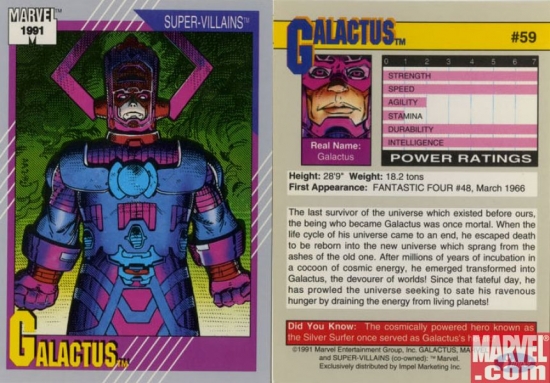
“The art seems like the obvious answer for everyone, right?” Fiffe said. “It definitely was for me, as I was never interested in factoids or stats. But look at the duo shade that Art Adams was using, good lord. How about Steve Lightle’s X-Men or Romita, Jr.’s three different Daredevils or Erik Larsen’s Wolverine versus the Hulk (which I got autographed by Larsen at my very first ever con in Miami).”
“I can’t rave enough about those Art Adams cards. They had such personality to them. He brought scenes to life on little pieces of cardboard.”
Adams himself wonders why the cards haven’t maintained their popularity in the same way comics have, but around the time the comic market busted, so did the trading card market. Unlike comics, trading cards haven’t come back as completely, although in a strange way the two of them exist as mirrors of each other. Both face aging audiences without an influx of new fans to bolster their number and expand the lifespan of the medium like these very cards once did.
25 Years Later
It’s hard to believe, but 2015 marks the 25th anniversary of the first set of the Marvel Universe cards, and people certainly haven’t forgotten about them. Brevoort for one says that editors who work with him today at Marvel grew up with a similar introduction to comics as myself, reading Marvel comics after the cards and the X-Men animated series taught them what the comics were all about. Bagley, Jusko and Adams shared that fans still bring the cards up at cons, sometimes in enormous stacks.
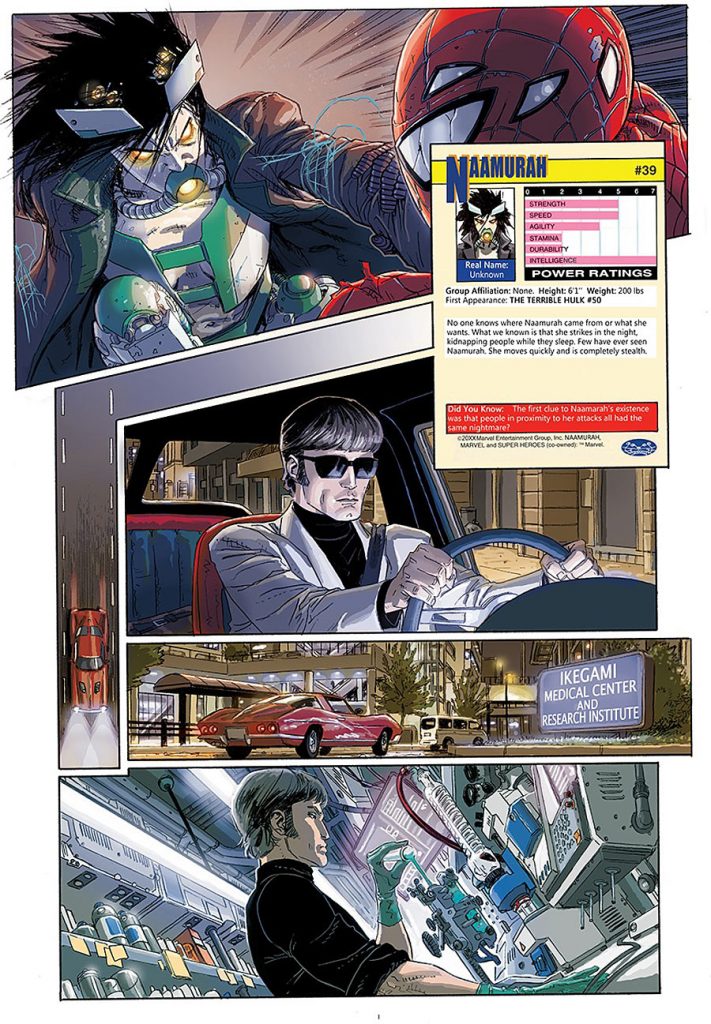
They live on in loving tributes from today’s creators, as well. Weaver for one used them as a visual tool to introduce readers to characters in his “Edge of Spider-Verse” issue, as he was creating mostly new characters for that comic.
“I wasn’t going to create characters that could be analogs of existing Marvel Characters. I wanted to create a completely unique cast for this Spidey, so part of the challenge was to make them seem legit,” he said. “In my mind, creating Marvel cards for the characters was a perfect way to tell some story and make it all seem legit — like this was another universe with its own history and importance.”
It was something that Weaver absolutely loved doing.
“I will say this, when I replicated the look of those cards, but with characters that I was creating, it gave me such pleasure. The idea of using the cards was justified in my mind for a lot of reasons, but there’s no doubt that it had a great nostalgic appeal for me.”
For his comic history of hip hop, “Hip Hop Family Tree”, Piskor will be creating cards to use as transition pieces for his weekly postings on Boing Boing when he’s traveling. The first one went up recently – it was the old backwards clothing wearing rappers Kriss Kross – and it was amazing. It’s designed as a tribute to the second series of the Marvel Universe cards, and his plan for them is pretty robust.
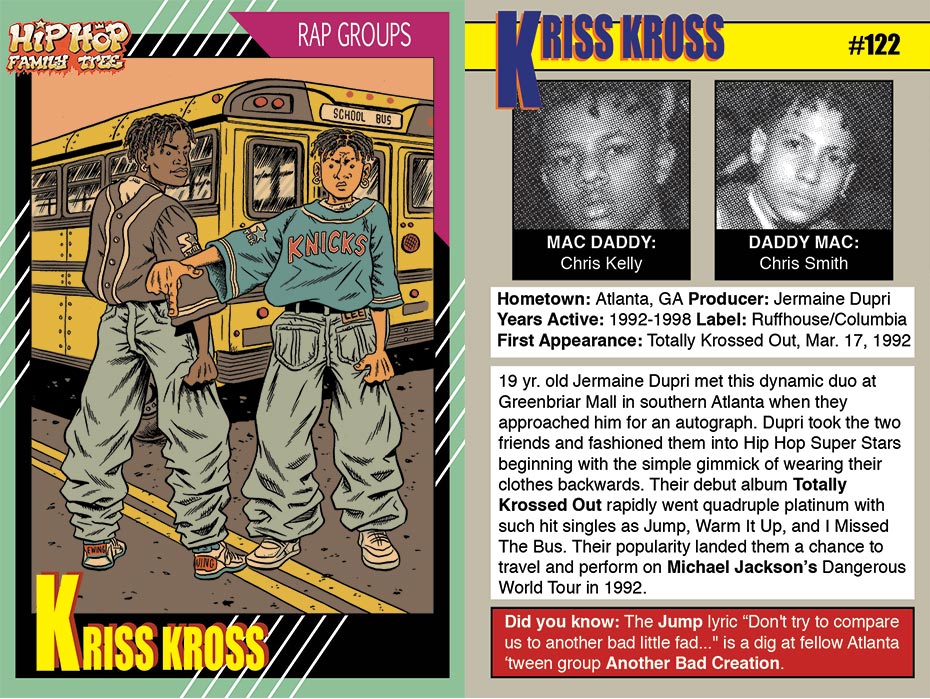
“I’m thinking this is going to have to be a book and cards, and I’ll talk with Fantagraphics about it, and if they don’t want to do it, I’m quite sure I’ll be able to do it elsewhere,” Piskor said. “It has to be 150 cards like Marvel series two. If it’s 150 cards and you have to multiply it by two to make a book, it’d be a 300-page book.”
“I don’t see it being done any time soon.”
Much to his delight, Jusko is getting a chance to run the whole thing back, as he’s working with Upper Deck to make a 25th Anniversary set of cards next year entirely painted by him.
“As popular as my set was I’ve always known it was far from my best work. That knowledge has picked at me for years,” Jusko said. “As the anniversary approached I contacted Upper Deck and proposed my interest in revisiting the property, with the request that I be given enough time to do the paintings and the brand itself justice.”
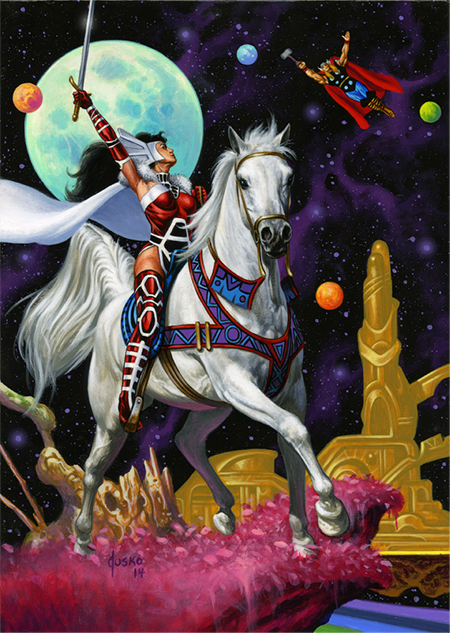
“I’m 20 years a better painter and really felt I could make this set something special.”
It’s a dream opportunity for Jusko, and so far, he’s loving it. While it is still a huge project, Jusko promises that each piece is “essentially cover quality art”, and from what we’ve seen, the project looks spectacular.
But even with that likely successful set in mind, I had to wonder, could something like the firebrand product the original Marvel Universe cards were happen again in this era? Is there the market for those types of stat and information driven cards, or even the interest in the youth of today to make it as important of an item as it once was for the the readers of tomorrow?
Realistically, it isn’t likely. In 1990, these cards were affordable and something that filled a niche for kids that didn’t have comic shops nearby or the ability to access reprints. With digital comics and Wikipedia available as replacement resources, the need isn’t there like it once was, and with 25 years passing by, a bevy of societal and technological shifts changed what kids are interested in today. The product has changed as well, now favoring more art centric cards like Jusko’s upcoming set and ones that incorporate Magic: The Gathering like gaming elements into them. Beyond that, when Marvel worked with Impel on those cards, it was the rare perfect intersection between Marvel’s publishing and licensing sides, creating something that integrated the knowledge and content of the former into the product of the latter. Brevoort shared that it is hard to imagine that happening again.
“The specific deal that created those cards…I don’t know if it could be duplicated exactly that way today,” he said. “I do think we have deals to do trading cards of one sort or another. They’re not as closely aligned with Marvel publishing and editorial as they were in those days because the licensing end of Marvel and the publishing end of Marvel are just bigger and consequently more autonomous and bifurcated.”
Even without those types of cards ever being as effective as they once were, they’re still hugely important relics of a time gone by. In a way, the cards exist as a snapshot of an era, showing off not just the characters who were important then, but also the artists who were once at the top of the House of Ideas. You can see that in how the characters and artists changed from series to series, with each set representing the year they were made and what made Marvel special at the time. For many, they’re just those cards they see at nearly every garage sale they go to. But for some, they’re timeless, even as they exist mostly in nostalgia fueled memories and dust covered binders today.
Thanks to Chris D’Lando, Tom Brevoort, Bob Budiansky, Arthur Adams, Mark Bagley, Joe Jusko, Dustin Weaver, Michel Fiffe, Matt Wilson, Michael Walsh, Ed Piskor, Dave Scheidt and the incredibly useful Big Marvel Cards Tumblr and Marvel.com for the assistance and resources in putting this together.
